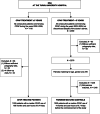Motor vehicle accidents in CPAP-compliant obstructive sleep apnea patients-a long-term observational study
- PMID: 32060778
- PMCID: PMC7426312
- DOI: 10.1007/s11325-020-02023-2
Motor vehicle accidents in CPAP-compliant obstructive sleep apnea patients-a long-term observational study
Abstract
Purpose: Obstructive sleep apnea (OSA) has been associated with a 2- to 7-fold risk of motor vehicle accidents (MVAs). Continuous positive airway pressure (CPAP) treatment may reduce MVA risk. We further explored this issue in long-term CPAP users and untreated controls.
Methods: We used both before-after and case-control study designs. The observational cohort consisted of CPAP-treated and untreated patients matched for gender, age, and apnea-hypopnea index. All MVAs reported to the police were identified.
Results: A total of 2060 patients (75.8% male, mean age 56.0 ± 10.5 years) were included. The CPAP-treated patients (N = 1030) were screened for MVAs for a median of 9.0 years before and after treatment. The median CPAP usage was 6.4 h/day. The control patients (N = 1030) were screened for MVAs for a median of 6.5 years after discontinuation of CPAP. No significant differences were observed between the incidences of MVAs per 1000 person years before treatment (3.2), after treatment (3.9), or in controls (2.6). Compared with controls, patients who had MVA after treatment had a higher body mass index (BMI), but did not differ in terms of other baseline characteristics, sleep study data, or accident conditions. In the majority of these patients, daytime sleepiness was reduced, whereas BMI tended to increase during treatment.
Conclusions: The MVA incidence did not change after CPAP treatment. Among the patients who had MVA, BMI was the only baseline characteristic that differed between the groups and tended to further increase after CPAP treatment. Differences in sleep study data or accident conditions were not observed.
Keywords: Continuous positive airway pressure; Motor vehicle accident; Obstructive sleep apnea; Real-world study.
Conflict of interest statement
The authors declare that they have no conflict of interest.
Figures


Similar articles
-
Sleep apnea-related risk of motor vehicle accidents is reduced by continuous positive airway pressure: Swedish Traffic Accident Registry data.Sleep. 2015 Mar 1;38(3):341-9. doi: 10.5665/sleep.4486. Sleep. 2015. PMID: 25325460 Free PMC article.
-
Risk of Motor Vehicle Accidents in Obstructive Sleep Apnea: Comparative Analysis of CPAP Versus Surgery.Otolaryngol Head Neck Surg. 2025 Apr;172(4):1459-1467. doi: 10.1002/ohn.1131. Epub 2025 Jan 21. Otolaryngol Head Neck Surg. 2025. PMID: 39838853 Free PMC article.
-
Elevated risk of motor vehicle accident for male drivers with obstructive sleep apnea syndrome in the Tokyo metropolitan area.Tohoku J Exp Med. 2009 Sep;219(1):11-6. doi: 10.1620/tjem.219.11. Tohoku J Exp Med. 2009. PMID: 19713679
-
Sleepiness and Driving: The Role of Official Regulation.Sleep Med Clin. 2019 Dec;14(4):491-498. doi: 10.1016/j.jsmc.2019.08.006. Epub 2019 Sep 25. Sleep Med Clin. 2019. PMID: 31640877 Review.
-
Impact of continuous positive airway pressure on vascular endothelial growth factor in patients with obstructive sleep apnea: a meta-analysis.Sleep Breath. 2019 Mar;23(1):5-12. doi: 10.1007/s11325-018-1660-4. Epub 2018 Apr 18. Sleep Breath. 2019. PMID: 29671205 Review.
Cited by
-
Implementation of European national driving regulations for obstructive sleep apnoea: challenges and recommendations.Eur Respir J. 2025 Jul 24;66(1):2402484. doi: 10.1183/13993003.02484-2024. Print 2025 Jul. Eur Respir J. 2025. PMID: 40341050 Free PMC article.
-
Response to the letter entitled "Which treatments are effective in preventing motor vehicle accidents in patients with obstructive sleep apnea?".Sleep Breath. 2023 Oct;27(5):1943. doi: 10.1007/s11325-023-02805-4. Epub 2023 Mar 6. Sleep Breath. 2023. PMID: 36877354 No abstract available.
-
Which treatments are effective in preventing motor vehicle accidents in patients with obstructive sleep apnea?Sleep Breath. 2023 Oct;27(5):1941-1942. doi: 10.1007/s11325-023-02804-5. Epub 2023 Mar 4. Sleep Breath. 2023. PMID: 36869988 No abstract available.
-
Digital Care Pathway for Patients With Sleep Apnea in Specialized Care: Mixed Methods Study.JMIR Hum Factors. 2024 Feb 22;11:e47809. doi: 10.2196/47809. JMIR Hum Factors. 2024. PMID: 38386368 Free PMC article.

